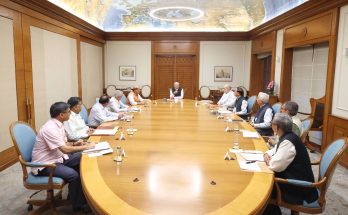 In a sign of assertion, hundreds of protesting Vietnamese activists marked the 40 anniversary of the Chinese invasion of the contested Paracel Islands in South China Sea January 19, reviving focus on the long-standing territorial dispute between the two neighbours.
In a sign of assertion, hundreds of protesting Vietnamese activists marked the 40 anniversary of the Chinese invasion of the contested Paracel Islands in South China Sea January 19, reviving focus on the long-standing territorial dispute between the two neighbours.
Known as the Xīshā Islands in Chinese and Hoàng Sa Islands in Vietnamese, the Paracel islands cover an area of less than 8 sq km. in the South China Sea. The islands are of strategic importance to both nations because they are said to be surrounded by productive fishing grounds and potential oil and gas reserves. Although the dispute over the Paracels started as long ago as 1909, the arguments over maritime space have been relatively recent. However, even four decades after the Chinese invasion, the peaceful resolution of the conflict has been obstructed by claims of absolute sovereignty by both nations and continues to cast its lingering shadow over the already troubled Sino-Vietnam relations.
Conflicting claims
Vietnam argues that the feudal Government of Vietnam or the Dai Vet under the Le, Tay Son and Nyugen dynasties had effectively enforced their administration over the Hoang Sa from the 17th to the 19th century. This continued even when an imperial France exercised Vietnam’s sovereignty over the islands. Following the fall of South Vietnam in 1975, Vietnam had declared that its territorial waters included the Paracel and Spratly Islands and established an exclusive 200 mile economic zone in 1977. China, on the other hand, argues that it has cultural relics and evidences dating back to the Tang, Song, Yuan and the Qing dynasties as proof of its sovereignty over the region. The PRC had even stationed a small platoon on Woody Island in the Paracels in the 1950s post the second Sino-Japanese war. Tensions over the islands continued to rise unceasingly since then.
On January 16 1974, reports of suspicious activities by the PLA in the Duncan and Drummond islands began to emerge in South Vietnam. To defend their sovereignty over the region, the South Vietnam Government sent a unit of frigates to the area. Two days later, there were sea and land battles between the Chinese and the South Vietnam’s forces, ultimately resulting in South Vietnam’s defeat. The South Vietnamese Government then immediately denounced to the world China’s forceful invasion of the Paracels (Hoang Sa) and reaffirmed its sovereignty over the archipelagoes.
On January 20, 1974, the Minister of Foreign Affairs of the Government of the Republic of Vietnam also telephoned and cabled the President of the UN Security Council and the UN Secretary General to call for urgent measures to stop China’s forceful seizure of the Hoang Sa. And with the war raging in Vietnam, no military attempt was made to re-engage the PRC over the islands. After its victory though, the PRC acquired the entire archipelago and has taken control of Paracel Islands ever since.
Resolution Strategies
T he Vietnamese way: While military action by the Chinese PLA forces impacted bilateral relations adversely between the two countries in the 1970s, the contemporary global scenario today demands that economics prevails over military might. China is one of the biggest markets for Vietnamese goods today and it is predicted that the PRC will become Vietnam”s largest single trading partner, overtaking the United States, by 2030.
he Vietnamese way: While military action by the Chinese PLA forces impacted bilateral relations adversely between the two countries in the 1970s, the contemporary global scenario today demands that economics prevails over military might. China is one of the biggest markets for Vietnamese goods today and it is predicted that the PRC will become Vietnam”s largest single trading partner, overtaking the United States, by 2030.
Vietnam, however, is also aware that if the Paracel Islands remain in China”s possession for another few years, it would ultimately translate into a permanent loss of the archipelago for Hanoi and would also have disastrous implications on Vietnam’s security (and consequently on Asian online casino canada balance of power). Given the complexities involved, Vietnam has, therefore, been forced to adopt a multi-pronged approach on the contentious issue.
On the international front, Vietnam has been increasingly asserting its sovereign rights over the region at multilateral fora like the ASEAN through diplomatic presence and public statements. Official consultations with the Philippines, the US and other Asian nations have also helped in sourcing support on the issue. The growth of Vietnam’s military ties with the US in this context has been particularly noteworthy – given that the unmistakable driver for this relationship is a shared concern about China.
Marking the anniversary of the 1974 battle for the first time in 40 years, dozens of activists laid flowers at a statue of Ly Thai To, a nationalist figurehead, in Hanoi to commemorate the death of the soldiers in the battle. Activists also waved banners and shouted “Hoang Sa, Truong Sa [Spratlys] belong to Vietnam!” The protests symbolised a growing increasing discontent among the Vietnamese against China’s claims in the region. Further, in April 2013, Vietnam’s National Boundary Commission had demanded that China cancel its plan to bring tourists to the Paracel archipelago by sending in a diplomatic note to the Chinese Embassy in Hanoi. In July 2012, the National Assembly of Vietnam had also passed a law, demarcating Vietnamese sea borders to include the Paracel and Spratly Islands.
Chinese assertion: The PRC, however, has chosen to adopt a diametrically opposite approach. In his speech at the China-ASEAN Expo in Nanning, Guangxi in September 2012, Xi Jinping, China’s then vice-president, had said: “We are firm in safeguarding China”s sovereignty, security and territorial integrity and are committed to resolving differences with neighbours concerning territorial land, territorial sea and maritime rights and interests peacefully through friendly negotiations.” The above statement was essentially Xi’s shorthand for the South China Sea dispute.
China has categorically emphasised its view of not ‘internationalising’ the issue and wants to solve the dispute through bilateral means. “We do not want to give over emphasis to the territorial disputes and differences, and we don”t think it”s a good idea to spread a sense of tension in this region,” China’s then Premier Wen Jiabao had stated at the 2012 ASEAN summit in Cambodia. In October 2013 at Brunei, China’s President Xi Jinping too had sidestepped the issue and had simply repeated his predecessor’s calls for bilateral dialogue. What (unintentionally) propels China’s stand on the issue is the US’ non-committal stand. In a conscious effort to not rock the boat with regard to its ‘rebalancing’ strategy in Asia, the US has refused to side with any one country on the issue- the evidence being Barack Obama’s ambiguous statement at ASEAN 2013 wherein he merely urged to “rein in” tensions over the issue.
The PRC, however, is ramping up its military machinery to advance its sovereignty claims over the region. Since the mid-1990s, China had acquired 12 Russian-made Kilo-class non-nuclear-powered attack submarines (SSs) and deployed at least four new classes of indigenously built submarines. in September 2012, The Wall Street Journal had reported the delivery and commissioning of “Liaoning ” – China’s first aircraft carrier for use in the South China Sea region. The largest ship to be delivered to the Chinese navy to date, this carrier when operational, could have a significant influence on its maritime dispute with Vietnam. The China Maritime Surveillance and the Fisheries Law Enforcement Command agencies have also deployed two fisheries patrol boats, the Yuzheng 311 and 310, while CMS patrol vessels, the Haijian 75 and 84, embarked on operations respectively in 2010 and 2011.
Conclusion
C hina is well aware of the fact that areas near the Paracel archipelago could be an important source of its energy requirements and would do everything possible to secure its economic interests. Driven by a fierce need to protect its sovereignty over the islands, China has recently begun to display an increasing military and diplomatic assertiveness in the region. In turn, Vietnam has chosen to mobilise the international community and has been consistently conveying concerns over security in the East Asia region.
hina is well aware of the fact that areas near the Paracel archipelago could be an important source of its energy requirements and would do everything possible to secure its economic interests. Driven by a fierce need to protect its sovereignty over the islands, China has recently begun to display an increasing military and diplomatic assertiveness in the region. In turn, Vietnam has chosen to mobilise the international community and has been consistently conveying concerns over security in the East Asia region.
While multilateral forums ASEAN have ensured that there has been no further escalation of the conflict, there has been no real de-escalation either. For now, the Paracel islands issue remains embroiled in a stalemate, with an assertive PRC making the prospects of any dispute settlement rather bleak. Vietnam, however, is in no mood to oblige, and has decided to step up a public diplomacy offensive to prevent the permanent loss of the islands to China.
(The views expressed in this article are solely those of the author)
Author Profile
- India Writes Network (www.indiawrites.org) is an emerging think tank and a media-publishing company focused on international affairs & the India Story. Centre for Global India Insights is the research arm of India Writes Network. To subscribe to India and the World, write to editor@indiawrites.org. A venture of TGII Media Private Limited, a leading media, publishing and consultancy company, IWN has carved a niche for balanced and exhaustive reporting and analysis of international affairs. Eminent personalities, politicians, diplomats, authors, strategy gurus and news-makers have contributed to India Writes Network, as also “India and the World,” a magazine focused on global affairs.
Latest entries
 India and the WorldJune 26, 2025Operation Sindoor: India Sheds Restraint, Rediscovers Utility of Force
India and the WorldJune 26, 2025Operation Sindoor: India Sheds Restraint, Rediscovers Utility of Force India and the WorldJune 23, 2025BRICS summit in Rio to focus on Global South, local currency trade
India and the WorldJune 23, 2025BRICS summit in Rio to focus on Global South, local currency trade Africa InsightsJune 11, 2025New Opportunities in India-Japan Cooperation in Africa
Africa InsightsJune 11, 2025New Opportunities in India-Japan Cooperation in Africa India and the WorldMay 23, 2025Post-Operation Sindoor, India reminds Turkey, China of concerns and sensitivities
India and the WorldMay 23, 2025Post-Operation Sindoor, India reminds Turkey, China of concerns and sensitivities







